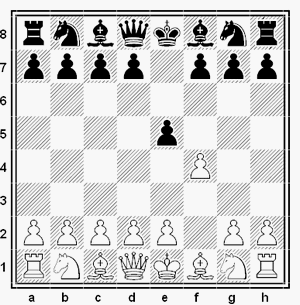Opening Gambits
{A} Gambits for White
[Note that the King's Gambit and the Queen's Gambit have already been covered]
1. 2.
2.
1. The Danish Gambit is very similar to the Goring, and the Scotch and they can transpose into each other.
1.e4 e5 2.d4 exd4 3.c3. White sacrifices a pawn for open lines and rapid development.
2. The Goring Gambit 1.e4 e5 2.Nf3 Nc6 3.d4 exd4 4.c3 White sacrifices one or two pawns for an advantage in development....dxc3 5.Bc4 cxb2 6.Bb2
3. 4.
4.
3. Scotch Gambit 1.e4 e5 2.Nf3 Nc6 3. d4 exd4 4.Bc4 White delays the recapture of the d4 pawn, developing quickly with O-O. He may play c3 as in the Goring, or simply recapture with the Knight.
4. Evans Gambit 1.e4 e5 2.Nf3 Nc6 3. Bc4 Bc5 4.b4 White offers a pawn to get a big centre and an advantage in development...Bxb4 5.c3 and d4, Qb3 etc.
5. 6.
6.
5. The Wing Gambit
1.e4 c5 {Sicilian Defence}2.b4 White offers a pawn to get rid of the c5 pawn so he can set up a big centre with d4.
6. The Tartakower Morra Gambit
1.e4 c5 {Sicilian Defence} 2.d4 cxd4 3.c3 Again White offers a pawn. He gets play down the c and d files and rapid development.
7. 8.
8.
7. The Blackmar Diemer Gambit
1.d4 d5 2.e4 dxe4 3. Nc3 Nf6 4.f3 White gets the e and f files - and an advantage in development.
8. The Staunton Gambit
1.d4.f5 [the Dutch Defence] 2.e4 White offers a pawn, fxe4 3. Nc3 Nf6 Now White can continue 4.Bg5 or f3 with the initiative.
9. 10.
10.
9. The Slav Gambit
1.d4.d5 2.c4 c6 3.Nf3 Nf6 4.Nc3 dxc4 5. e4 Now with b5 Black can hold on to an extra pawn, but White has the centre.
10. The Marshall Gambit
1.d4.d5 2.c4 c6 3.Nf3 e6 4.e4 Now with dxe4 5.Nxe4 Bb4+ 6.Bd2 !? White offers a pawn Qxd4 7.Bxb4 Qxe4+. White has the 2 Bishops and Black’s Queen is exposed to attack.
11.
11. The Botvinnik Semi Slav
1.d4.d5 2.c4 c6 3.Nf3 Nf6 4.Nc3 e6 5. Bg5 White sacrifices his c-pawn, dxc4 6. e4 b5 7.e5 h6 8. Bh4 g5 9.Nxg5 hxg5 10.Bxg5 with an extremely complex position.
{B} Gambits for Black
1. 2.
2.
1. The Latvian Gambit
1.e4 e5 2.Nf3 f5 Black attempts to play a King’s Gambit. Main line is 3.Nxe5 Qf6 4.d4 d6 5.Nc4 fxe4 6.Nc3 Qg6
2. Queen’s Pawn Counter Gambit Black gains free play for his pieces. 1.e4 e5 2.Nf3 d5 3.exd5 e4 4.Qe2 Nf6
3. 4.
4.
3. Centre Counter Gambit 1.e4 d5 2.exd5 Nf6 3.c4 c6 4.dxc6 Nxc6 Black has sacrificed a pawn but has rapid development and saddled White with a backward d pawn.
4. Falkbeer Counter Gambit A highly respected counter to the King’s Gambit. 1.e4 e5 2.f4 d5 3.exd5 e4 This pawn gives White problems.
5. 6.
6.
5. The Albin Counter Gambit
1.d4 d5 2.c4 e5 Black sacrifices a pawn for rapid and free development and gains a pawn at d4 as a thorn in White’s side. 3.dxe5 d4
6. Von Henig Schara Gambit
1.d4 d5 2.c4 e6 3.Nc3 c 5[Tarrasch] 4.cxd5 cxd4 A dangerous gambit. Black sacrifices a pawn for rapid and free development 5.Qa4+ Bd7 6.Qxd4 exd5 7.Qxd5 Nc6
7. 8.
8.
7. Winawer Gambit
1.d4 d5 2.c4 c6 3.Nc3 e5 4.cxd5 cxd5 5.dxe5 d4 - The point ! Knight moves then Qa5+ regaining the e pawn.
8. The Budapest
1.d4 Nf6 2.c4 e5 This wild looking move is considered sound. After 3.dxe5 Ng4 4.Nf3 Nc6 5. Bf4 Bb4+ 6. Nbd2 Qe7 Black will recover his pawn.
9. 10.
10.
9. Englund Gambit 1.d4 e5 2.dxe5 Nc6 3. Nf3 Qe7 [for if Bf4 then Qb4+]
10. From Gambit 1.f4 {Bird’s opening} e5 This is a dangerous reply. 2.fxe5 {instead White can play 2.e4 transposing into the King’s Gambit} d6 3.exd6 Bxd6 {Black is already threatening Qh4+} 4. Nf3 g5 threat g4, if Knight moves Qh4+. Black has a K-side attack for the pawn.
11. 12.
12.
11. Blumenfield Gambit 1.d4 Nf6 2.c4 e6 3.Nf3 c5 4.d5 b5 Black offers a pawn to gain pawns at e6 d5 and c5
12. Benko Gambit 1.d4 Nf6 2.c4 c5 3.d5 b5 Similar to the Blumenfield. Black offers a pawn and in return gets strong Q-side pressure.
 2.
2.
 2.
2.
 4.
4.
 6.
6.
 8.
8.
 10.
10.

 2.
2.
 4.
4.
 6.
6.
 8.
8.
 10.
10.
 12.
12.